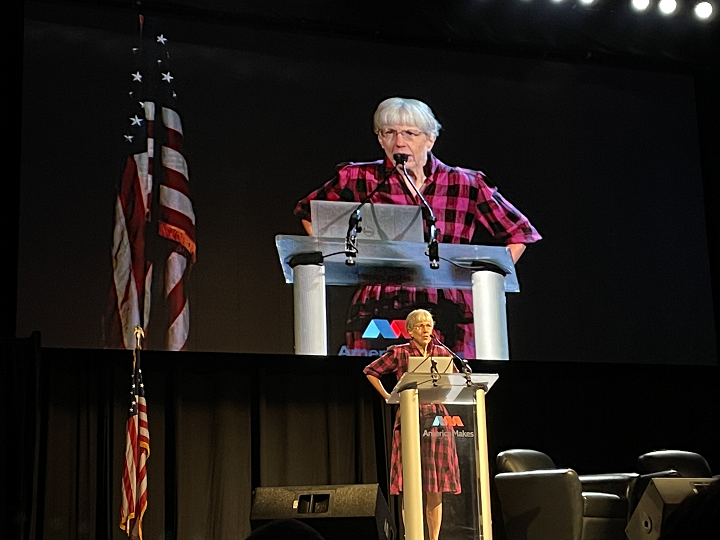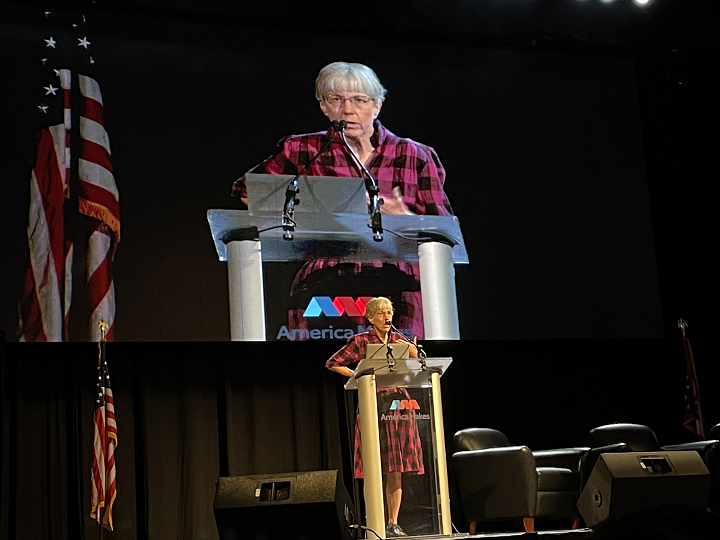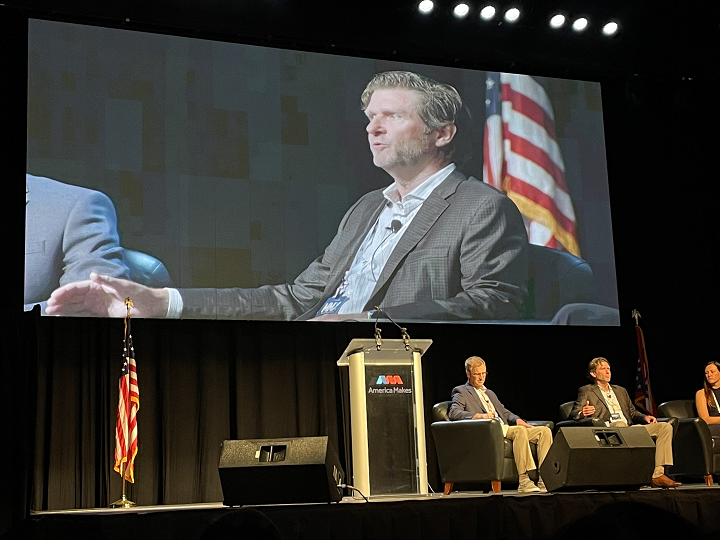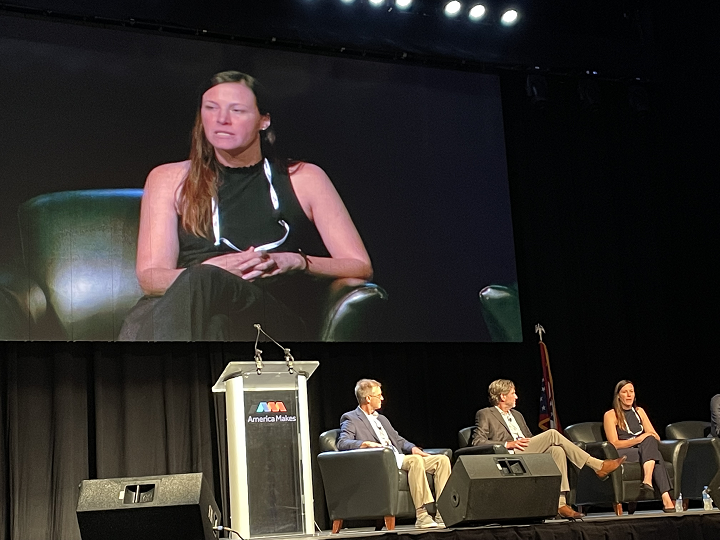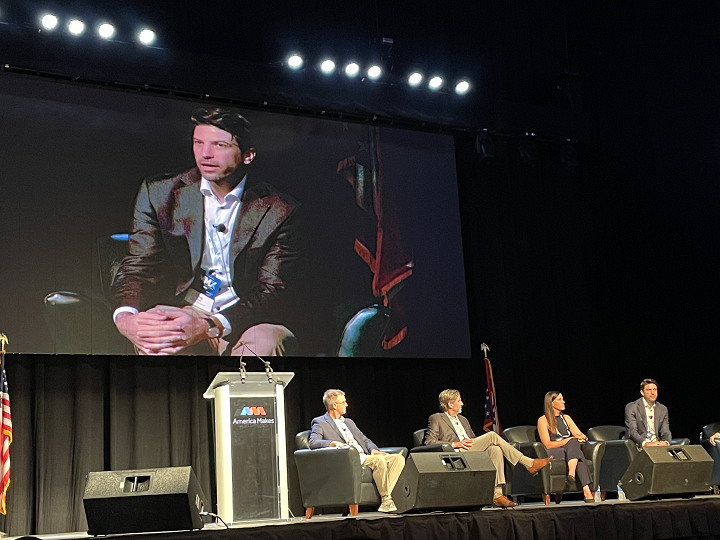America Makes is the United States’ leading public-private partnership for additive manufacturing (AM) technology and education, working to not only accelerate adoption of the technology in the country, but also to increase our manufacturing competitiveness through training, standards publication, projects, and more. The organization, which was the first of the Manufacturing USA Advanced Manufacturing Institutes, opened its doors in Youngstown, Ohio in 2012, and 3DPrint.com was on hand to celebrate its fifth birthday in 2017. So, of course, I made the nearly four-hour drive from my home in Dayton to help celebrate its 10th anniversary at MMX 2022, the Members Meeting and Exchange event for the more than 230 members of America Makes.
In part one of my coverage of MMX 2022, I discussed the lead up to and first moments of the event. The day continued with exciting guests and panels. This included Dr. Susan Helper, a professor at Case Western Reserve University and the Senior Economist on the White House Council of Economic Advisors, who provided an overview of the manufacturing priorities for the U.S.
White House Senior Economist Susan Helper
Dr. Helper explained that the U.S. has “failed to make important investments” over the last several decades, which has resulted in supply chain issues and unequal economic growth, and this was really on display during the pandemic. But, Dr. Helper said that additive manufacturing can play an important role in not repeating our past mistakes, and that the first strategy is redundancy and eliminating inventory, which, while at times unavoidable, is expensive.
“Inventory is kind of a last resort,” she said. “It’s better to use another strategy, like agility, in responding quickly to problems, which requires workforce strategies to solve problems on the shop floor or bring in new materials, and it requires new technologies, like additive manufacturing.”
As we all know, with AM, parts can be printed and delivered much more quickly, and it’s definitely easier to store designs and files than physical objects. Additionally, long lead times for technologies like casting and forging are majorly reduced, and companies and the government won’t be as dependent on this kind of labor-intensive machining either. At Case Western, Dr. Helper was on the team that wrote the initial grant that brought America Makes to life, and she said that the institute is “at the forefront of some of these developments.”
“Some approaches to public-private partnerships that America Makes has pioneered are helpful, like prioritizing investments and, through the OSD and AFRL ManTech teams, executing applied research, and just bringing the vast range of additive manufacturing technologies to the forefront,” she said.
Dr. Helper noted that AM Forward, which supports adoption of this “critical technology,” would not have happened without America Makes. She explained that the initiative builds on a lot of the work the institute has done to get metal 3D printers up and running with suppliers, and that through AM Forward, “we are going to ensure that small manufacturers can access financing so they can get these machines,” as well as qualify machines and materials, and offer workforce development and training. She also announced the two newest members of AM Forward, Boeing and Northrop Grumman, which agreed as part of the initiative to make a public commitment to help suppliers by including them in RFPs and helping them find financing.
3D Printer Manufacturers and More
The first panel of the day was on “Building and Scaling Additive Manufacturing Supply Chains,” moderated by Kimberly Gibson, Additive Manufacturing Ecosystem Director at America Makes, and welcoming panelists Rick Lucas, the CTO of ExOne; Jeff Hemenway, Senior Vice President, Global Industrial Sales, for Stratasys; Samantha Snabes, Co-founder: Catalyst, re3d; and Greg Hayes, Senior Vice President Applied Technology at EOS.
Gibson got things started by asking how we as an industry can work on “unsticking” the fear of additive manufacturing, and Lucas said that the risk in the minds of potential adopters needs to be addressed. He said that some customers are “willing to take a small bite, but not the full apple,” so addressing their fears little by little helps get them comfortable. According to Hemenway, the three primary issues here are “awareness of the value and capabilities and limitations,” followed by high costs, and then workforce.
“GM works with suppliers to create awareness with the AIC in Detroit, almost acting as a service bureau themselves to run parts for suppliers that are just getting started,” he said as an example. “OEMs have to figure out how to support their suppliers.”
Snabes explained that re3d is passionate about making its technologies seem more approachable, and thinks a lot about the language it’s using, noting that people can often remember stories better than the names of specific machines. Hayes said that we all need to acknowledge that we’re still in an emerging technology, as manufacturers in America are still using more traditional methods, and that we won’t see the tipping point until “we start solving their problems.” He noted that EOS is proud to offer online learning, but that in a perfect world, middle schools and trade schools and universities would already have the necessary AM fundamentals to offer this.
Gibson asked what their customers are saying they need in order to scale AM technology for use in their businesses. Hayes said that we’ll “hit a dead end” if we look at AM as a substitution, and that “you have to think about your business case differently, and your end product, in order to justify how to make that product differently.” Lucas noted that the answer typically depends on the customer and the industry, but that the biggest demand now is consistency and repeatability from machine to machine, location to location, as well as more learning on what the technology is really capable of doing.
Hemenway agreed that it can really depend on the application and industry, noting that there are really interesting things happening with the technology in everything from textiles to healthcare and aerospace. But, he said that especially with those kinds of exacting industries, parts and serial numbers are what’s getting qualified, and that this needs to change, because “it doesn’t scale.”
“With the industrial base we all share, we’re quoting multiple units, and we don’t have trained operators. They need to know they can guarantee zero downtime, and the talent is just not there,” Snabes said. “As a small business, how do you support this training on the fly about a very specific widget that wasn’t taught in school? People who are ready to scale want the printer yesterday, and with the supply chain challenges, we can’t deliver fast enough or find the components we need. Our larger accounts want some guarantee that if they qualify a part, we can deliver.”
Lucas said you need to find the champions willing to take the risk, who are often colleagues of others in the space, like Humtown Products. The risk-takers have had the most success because they believe in it the most.
Gibson also asked what kind of incentive structure would allow this to move more quickly. Hemenway stated that we need a way to ensure continuous engagement with companies that acquire 3D printers to see if they’re actually using them, and Hayes said that it’s more playing matchmaker than just financial issues, and that “America Makes and AM Forward can help.”
“In America, in general, lots of really good manufacturing exists today, and there’s a bridge between them, but it’s difficult to cross,” he continued. “So finding an application to be developed for a process, and having America Makes offer financial support and training to make it successful, would be great.”
Before breaking for lunch, Gibson addressed the room, reminding us that we must collaborate in order to relentlessly pursue the goals outlined on the stage. In the next article in this series, I cover one collaborative effort led by the U.S. Air Force, the Pacer Edge program, in which GE Aerospace is developing the protocols necessary to 3D print aerospace parts that typically have long lead times.
Subscribe to Our Email Newsletter
Stay up-to-date on all the latest news from the 3D printing industry and receive information and offers from third party vendors.
You May Also Like
3D Printing Unpeeled: New Arkema Material for HP, Saddle and Macro MEMS
A new Arkema material for MJF is said to reduce costs per part by up to 25% and have an 85% reusability ratio. HP 3D HR PA 12 S has been...
3D Printing News Briefs, January 20, 2024: FDM, LPBF, Underwater 3D Printer, Racing, & More
We’re starting off with a process certification in today’s 3D Printing News Briefs, and then moving on to research about solute trapping, laser powder bed fusion, and then moving on...
3D Printing Webinar and Event Roundup: December 3, 2023
We’ve got plenty of events and webinars coming up for you this week! Quickparts is having a Manufacturing Roadshow, America Makes is holding a Member Town Hall, Stratafest makes two...
Formnext 2023 Day Three: Slam Dunk
I’m high—high on trade show. I’ve met numerous new faces and reconnected with old friends, creating an absolutely wonderful atmosphere. The excitement is palpable over several emerging developments. The high...




